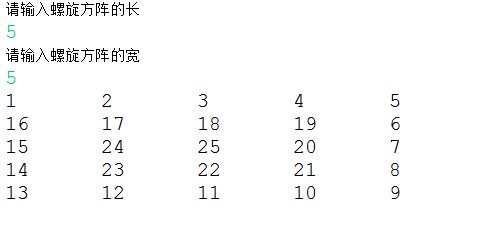一、模擬酒店房間管理系統(tǒng),需要如下幾個(gè)功能:
1、1 in 房間號(hào) 客人名字 入住功能
1、2 out 房間號(hào) 退房功能
1、3 search 房間號(hào) 查詢房間狀態(tài) 如果房間號(hào)為-1 則輸出所有房間狀態(tài)
1、4 quit 或 exit 退出
提示:酒店所有的房間用二維數(shù)組來(lái)實(shí)現(xiàn)
代碼實(shí)現(xiàn)如下:
|
1
2
3
4
5
6
7
8
9
10
11
12
13
14
15
16
17
18
19
20
21
22
23
24
25
26
27
28
29
30
31
32
33
34
35
36
37
38
39
40
41
42
43
44
45
46
47
48
49
50
51
52
53
54
55
56
57
58
59
60
61
62
63
64
65
66
67
68
69
70
71
72
73
74
75
76
77
78
79
80
81
82
83
84
85
86
87
88
89
90
91
92
93
94
95
96
97
98
99
100
|
import java.util.Scanner;public class HotelDemo { //寫在類里面,則每個(gè)方法都可以訪問(wèn)到,避免了參數(shù)傳遞的繁瑣; static int h=5,w=10; static String[][] rooms=new String[5][10]; public static void main(String[] args) { @SuppressWarnings("resource") Scanner s=new Scanner(System.in); while(true){ System.out.println("請(qǐng)輸入 in,out,search,quit:"); String temp=s.next(); int room=0; if("in".equals(temp)){//防止出現(xiàn)空指針異常; System.out.println("輸入房間號(hào):"); room=s.nextInt(); System.out.println("輸入名字:"); String name=s.next(); if(in(room,name)) System.out.println("入住完成!"); System.out.println("room"+room+"name"+name); }else if("out".equals(temp)){ System.out.println("輸入房間號(hào):"); room=s.nextInt(); if(out(room)) System.out.println("退房完成!"); System.out.println("out"+room); }else if("search".equals(temp)){ System.out.println("輸入房間號(hào)(-1代表全部):"); room=s.nextInt(); search(room); }else if("quit".equals(temp)||"exit".equals(temp)){ break; }else{ System.out.println("命令錯(cuò)誤!"); } } } private static boolean search(int room) { if(room==-1){ //打印所有的信息; for(int i=0;i<h;i++){ for(int j=0;j<w;j++){ int room2=(i+1)*100+j+1; System.out.print(room2+"\t"); } System.out.println(); for(int k=0;k<w;k++){ System.out.print(rooms[i][k]==null?"empty":rooms[i][k]); System.out.print("\t"); } System.out.println(); System.out.println(); } return true; }else{ int r=room/100-1; int c=room%100-1; if(r<0||r>=h||c<0||c>=w){ System.out.println("房間號(hào)錯(cuò)誤!"); return false; } System.out.println(rooms[r][c]==null?"empty":rooms[r][c]); return true; } } private static boolean out(int room) { int r=room/100-1; int c=room%100-1; if(r<0||r>=h||c<0||c>=w){ System.out.println("房間號(hào)錯(cuò)誤!"); return false; } if(rooms[r][c]==null||"".equals(rooms[r][c])){// System.out.println("此房間沒有人!"); return false; } rooms[r][c]=null; return true; } private static boolean in(int room, String name) { int r=room/100-1; int c=room%100-1; if(r<0||r>=h||c<0||c>=w){ System.out.println("房間號(hào)錯(cuò)誤!"); return false; } if(rooms[r][c]!=null){// System.out.println("此房間已經(jīng)有人!"); return false; } rooms[r][c]=name; return true; }} |
二、螺旋矩陣 例
|
1
2
3
4
5
6
7
8
9
10
11
12
13
14
15
16
17
18
19
20
21
22
23
24
25
26
27
28
29
30
31
32
33
34
35
36
37
38
39
40
41
42
43
44
45
|
import java.util.Scanner; public class SpiralSquare01{ public static void main(String[] args) { @SuppressWarnings("resource") Scanner s=new Scanner(System.in); System.out.println("請(qǐng)輸入螺旋方陣的長(zhǎng)"); int indexY=s.nextInt(); System.out.println("請(qǐng)輸入螺旋方陣的寬"); int indexX=s.nextInt(); if(indexX<=0||indexY<=0){ System.out.println("輸入的數(shù)字不合法!"); return; } int[][] square=new int[indexX][indexY]; int x=0; int y=0; for(int i=1;i<=indexX*indexY;){ while(y<square[x].length-1&&square[x][y+1]==0){ square[x][y++]=i++; } while(x<square.length&&square[x][y]==0){ square[x++][y]=i++; } while(y>0&&square[x-1][y-1]==0){ square[x-1][--y]=i++; } --x; while(x>1&&square[x-1][y]==0){ square[--x][y]=i++; } y++; } for(int i=0;i<square.length;i++){ for(int j=0;j<square[i].length;j++){ System.out.print(square[i][j]+"\t"); } System.out.println(); } }} |
運(yùn)行結(jié)果:

三、經(jīng)典數(shù)學(xué)問(wèn)題:百雞問(wèn)題的變形
題目描述:有36個(gè)人,36塊磚,每人搬了一次,正好搬完。其中男每人每次搬4塊,女每人每次搬3塊,小孩兩人每次搬一塊。問(wèn) 男、女、小孩各多少人?
|
1
2
3
4
5
6
7
8
9
10
11
12
13
14
15
16
17
18
19
20
21
|
public class TestBrick { public static void main(String[] args) { int manNum=0; int womanNum=0; for(int i=0;i<=9;i++){ for(int j=0;j<12;j++){ if(((i*4+j*3+(36-i-j)/2)==36)&&((36-i-j)%2==0)){ //注意:孩子的人數(shù)必須是偶數(shù),否則會(huì)出現(xiàn)一個(gè)孩子一次也沒有搬的情況,不符合題意 manNum=i; womanNum=j; System.out.println("男的的人數(shù)是"+manNum); System.out.println("女的的人數(shù)是"+womanNum); System.out.println("孩子的人數(shù)是"+(36-manNum-womanNum)); } } } } } |
四、倒計(jì)時(shí)的算法:輸入一個(gè)秒數(shù),要求轉(zhuǎn)換為XX小時(shí)XX分XX秒的格式輸出出來(lái)
|
1
2
3
4
5
6
7
8
9
10
11
12
13
14
15
16
17
18
19
20
21
22
|
import java.util.Scanner; public class TestTime { /** * @param args */ public static void main(String[] args) { // TODO Auto-generated method stub @SuppressWarnings("resource") Scanner s=new Scanner(System.in); System.out.println("請(qǐng)輸入秒數(shù):"); int second =s.nextInt(); int hour=second/3600; int minite=second%3600/60; int sec=second%60; System.out.println("轉(zhuǎn)換后為:"+hour+"小時(shí)"+minite+"分"+sec+"秒"); } } |
五、密碼的自動(dòng)生成器:密碼由大寫字母/小寫字母/數(shù)字組成,生成六位隨機(jī)密碼;
|
1
2
3
4
5
6
7
8
9
10
11
12
13
14
15
16
17
18
19
20
21
22
23
24
25
26
27
28
29
30
31
32
33
34
35
36
37
38
39
|
//密碼的自動(dòng)生成器:密碼由大寫字母/小寫字母/數(shù)字組成,生成六位隨機(jī)密碼;import java.util.Random; public class TestPassword { /** * @param args */ public static void main(String[] args) { // TODO Auto-generated method stub char[] pardStore=new char[62]; //把所有的大寫字母放進(jìn)去 for(int i=0;i<20;i++){ pardStore[i]=(char)('A'+i); } //把所有的小寫字母放進(jìn)去 for(int i=26;i<52;i++){ pardStore[i]=(char)('a'+i); } //吧0到9放進(jìn)去 for(int i=52;i<62;i++){ pardStore[i]=(char)('0'+(i-52)); } //生成6位隨機(jī)密碼 Random r=new Random(); for(int i=0;i<6;i++){ int n=r.nextInt(62); System.out.print(pardStore[n]); } } } |
六、寫一個(gè)彩票的生成代碼: 1-33隨機(jī)選7個(gè)不重復(fù)的數(shù)字;
|
1
2
3
4
5
6
7
8
9
10
11
12
13
14
15
16
17
18
19
20
21
22
23
24
25
26
27
28
|
import java.util.Random;//寫一個(gè)彩票的生成代碼: 1-33隨機(jī)選7個(gè)不重復(fù)的數(shù)字;public class TestLuckyTicket { /** * @param args */ public static void main(String[] args) { // TODO Auto-generated method stub int[] luckTickets=new int[7]; Random r=new Random(); for(int i=0;i<luckTickets.length;i++){ luckTickets[i]=r.nextInt(8)+1; for(int j=0;j<i;j++){ if(luckTickets[i]==luckTickets[j]){ i--; break; } } } for(int i=0;i<luckTickets.length;i++){ System.out.print(luckTickets[i]+","); } }} |
七、定義一個(gè)字符串變量String str="床前明月光,疑是地上霜。舉頭望明月,低頭思故鄉(xiāng)。"。
打印成如下格式的:
低 舉 疑 床
頭 頭 是 前
思 望 地 明
故 明 上 月
鄉(xiāng) 月 霜 光
。 , 。 ,
|
1
2
3
4
5
6
7
8
9
10
11
12
13
14
15
16
17
18
19
20
21
22
23
24
25
26
27
28
29
30
31
|
public class TestPoet { /** * @param args */ public static void main(String[] args) { // TODO Auto-generated method stub String str="床前明月光,疑是地上霜。舉頭望明月,低頭思故鄉(xiāng)。"; char[] poet=str.toCharArray(); int l=18; boolean flag=true; int i=0; while(flag){ for(int j=l;j>=(0+i);){ System.out.print(poet[j]); j=j-6; } System.out.println(); l++; i++; if(l==24){flag=false;} } } } |
八、九宮格的輸出:九宮格就是每一行,每一列,斜著的一列和反斜著的一列的所在的數(shù)字之和均相等;最基本的是三行三列=9格就是很出名的九宮格;還可以推廣到5*5=25個(gè)格;只要行和列的個(gè)數(shù)均相等并且是奇數(shù)就可以;
|
1
2
3
4
5
6
7
8
9
10
11
12
13
14
15
16
17
18
19
20
21
22
23
24
25
26
27
28
29
30
31
32
33
34
35
36
37
38
39
40
41
42
43
44
45
46
47
48
49
50
|
import java.util.Scanner;public class JiuGongGe { /** * @param args */ public static void main(String[] args) { // TODO Auto-generated method stub @SuppressWarnings("resource") Scanner s=new Scanner(System.in); System.out.println("請(qǐng)輸入一個(gè)大于等于3的奇數(shù)"); int length=s.nextInt(); if(length<3||length%2==0){ System.out.println("輸入的數(shù)字不合法!"); return; } int[][] nineTable=new int[length][length]; int indexX=0; int indexY=0; indexY=(nineTable.length-1)/2; nineTable[indexX][indexY]=1; for(int i=1;i<nineTable.length*nineTable.length;i++){ indexX--; indexY++; if(indexY>=nineTable.length&&indexX>=0){ indexY=0; }else if(indexX<0&&indexY<nineTable.length){ indexX=nineTable.length-1; }else if(indexY>=nineTable.length&&indexX<0){ indexY--; indexX=indexX+2; }else if(nineTable[indexX][indexY]!=0){ indexY--; indexX=indexX+2; } nineTable[indexX][indexY]=i+1; } for(int i=0;i<nineTable.length;i++){ for(int j=0;j<nineTable[i].length;j++){ System.out.print(nineTable[i][j]+" "); } System.out.println(); System.out.println(); } } } |
總結(jié)
以上就是這篇文章的全部?jī)?nèi)容了,希望本文的內(nèi)容對(duì)大家的學(xué)習(xí)或者工作能帶來(lái)一定的幫助,如果有疑問(wèn)大家可以留言交流,謝謝大家對(duì)服務(wù)器之家的支持。















